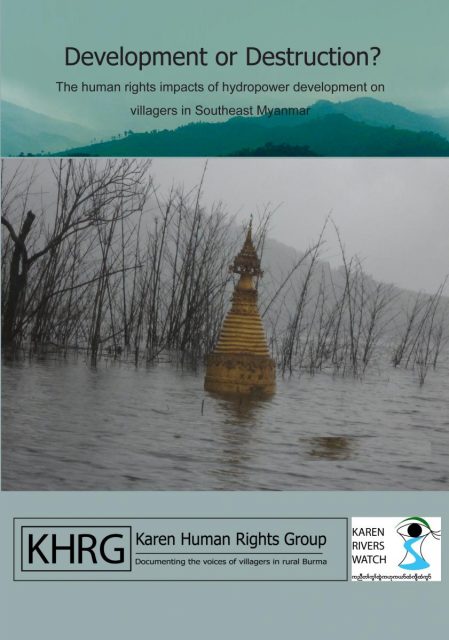Development or Destruction? The Human Rights Impacts of Hydropower Development on Villagers in Southeast Myanmar
10 July 2018


Executive summary
In Southeast Myanmar, electrification rates are among the lowest in the country, particularly in rural, conflict-affected areas near the border of Thailand. Myanmar’s ambitious National Electrification Plan (NEP) aims to provide electricity access to all Myanmar households by 2030. In response to the NEP and other national development goals, Myanmar’s Energy Master Plan (MEMP) projects electricity demand to rise by 10 percent annually through 2030. To meet future demands, Myanmar must expand its energy infrastructure. Currently, hydropower comprises two-thirds of Myanmar’s electricity generation capacity. Both the MEMP and alternative visions of electricity infrastructure development in Myanmar rely on hydropower as a key source of electricity through 2050, and include provisions for the export of hydropower to neighboring countries.
Myanmar needs to acknowledge and address a number of salient concerns if it going to use hydropower to meet its future electricity needs.
Most of Myanmar’s abundant hydropower resources are located in ethnic areas, particularly Kayin, Kayah, Kachin, and Shan States, all of which are sites of ongoing ethnic conflicts and armed tension. In many cases, development of large dams in ethnic areas has resulted in conflict, severe social and environmental impacts for local communities and human rights violations. The overwhelming majority (42 of 50) of large hydropower projects planned in Myanmar in recent years have been situated in ethnic areas. With many more projects slated for development in these areas, this report highlights how hydropower projects impact ethnic communities in Southeast Myanmar.
This report aims to encourage reforms in the hydropower sector by building comprehensive recommendations for policymakers and hydropower developers. The report supports recommendations using the results of new research highlighting how hydropower projects have impacted ethnic communities in Southeast Myanmar. Report commentary assesses the degree to which Myanmar’s legal and regulatory frameworks measure up against international best standards and practices for hydropower governance. The report concludes with comprehensive recommendations on how to strengthen these national frameworks in order to provide greater social and environmental safeguards for rural ethnic communities impacted by hydropower dams.
“If the dam is constructed, there will be flooding over all the villages, including villagers’ land, farms and plantations around that area. They [villagers] do not want it because the dam construction project will cause flooding. The flooding will drown all of their land and farms. Because of this, we will not have land to farm for our livelihoods.”
Pu Bm— , (male), Bn— village, Ler Muh Lah Township, Mergui-Tavoy District/ Tanin tharyi Region (Interviewed in March 2017)
Download full report in English HERE.
Download full report in Burmese HERE.
See this original post HERE.
Announcements
21 May 2025
Open letter: Malaysia must lead ASEAN with principle, not hypocrisy, to address the Myanmar crisis

Progressive Voice is a participatory rights-based policy research and advocacy organization rooted in civil society, that maintains strong networks and relationships with grassroots organizations and community-based organizations throughout Myanmar. It acts as a bridge to the international community and international policymakers by amplifying voices from the ground, and advocating for a rights-based policy narrative.